Maggiorana 🍃✨💚
The English version follows in the end.
Versione Italiana 🇮🇹🇮🇹🇮🇹

La Maggiorana (Origanum majorana), appartenente alla famiglia delle Lamiaceae, è una pianta erbacea perenne, spesso coltivata come annuale nelle zone più fredde. Originaria delle regioni mediterranee e dell'Asia occidentale, è molto apprezzata sia per il suo uso culinario che per le sue proprietà medicinali.
La Maggiorana ha un portamento cespuglioso e compatto, raggiungendo un'altezza di circa 30-60 cm. I suoi fusti sono sottili, di colore verde chiaro, a volte sfumati di rosso alla base, e leggermente legnosi nella parte inferiore. Le foglie sono piccole, ovali, vellutate al tatto, di colore verde e caratterizzate da un aroma dolce e delicato, che la differenzia dall'origano, suo parente stretto.
Durante la fioritura, che avviene tra giugno e settembre, la pianta produce piccoli fiori bianchi o rosati, raccolti in infiorescenze a spiga all'apice dei rami. Sebbene i fiori siano piuttosto discreti, attirano numerosi insetti impollinatori come api e farfalle, contribuendo alla biodiversità del giardino.
La Maggiorana preferisce posizioni soleggiate e terreni ben drenati, anche poveri, purché non vi siano ristagni d’acqua. È una pianta rustica che tollera la siccità, ma beneficia di annaffiature regolari, soprattutto nei periodi più caldi. Essendo sensibile al freddo, nelle regioni con inverni rigidi è consigliabile coltivarla in vaso.
In cucina, le foglie di maggiorana, fresche o essiccate, vengono utilizzate per insaporire carni, pesce, verdure e zuppe, grazie al loro sapore dolce e aromatico, che si sposa bene con molti piatti mediterranei. Oltre al suo uso culinario, la pianta è nota per le sue proprietà digestive, calmanti e antinfiammatorie. In fitoterapia, viene impiegata sotto forma di tisane e oli essenziali per alleviare problemi digestivi e stati di tensione nervosa.
E voi, utilizzate la Maggiorana in cucina o l'avete mai coltivata nel vostro orto o balcone? Fatemelo sapere nei commenti e lasciate un "like" se amate il profumo e il sapore di questa preziosa pianta! 🌿🍃✨💚
(Foto scattata da me) 📸
English version 🇬🇧🇬🇧🇬🇧

Marjoram (Origanum majorana), belonging to the Lamiaceae family, is a perennial herb, often grown as an annual in colder areas. Native to the Mediterranean regions and Western Asia, it is highly valued for both its culinary use and medicinal properties.
Marjoram has a bushy and compact growth habit, reaching a height of about 30-60 cm. Its stems are thin, light green, sometimes tinged with red at the base, and slightly woody at the lower part. The leaves are small, oval, velvety to the touch, green in color, and characterized by a sweet, delicate aroma, which distinguishes it from oregano, its close relative.
During its flowering season, from June to September, the plant produces small white or pinkish flowers arranged in spike-like inflorescences at the top of the stems. Although the flowers are rather subtle, they attract numerous pollinators like bees and butterflies, contributing to the garden's biodiversity.
Marjoram prefers sunny locations and well-drained soils, even poor ones, as long as water stagnation is avoided. It is a hardy plant that tolerates drought but benefits from regular watering, especially during hotter periods. Being sensitive to cold, it is advisable to grow it in pots in regions with harsh winters.
In the kitchen, marjoram leaves, either fresh or dried, are used to flavor meats, fish, vegetables, and soups, thanks to their sweet and aromatic taste, which complements many Mediterranean dishes. Besides its culinary use, the plant is known for its digestive, calming, and anti-inflammatory properties. In herbal medicine, it is used in teas and essential oils to relieve digestive issues and nervous tension.
Do you use marjoram in your cooking, or have you ever grown it in your garden or balcony? Let me know in the comments, and leave a "like" if you love the fragrance and flavor of this precious plant! 🌿🍃✨💚
(Photo taken by me) 📸
